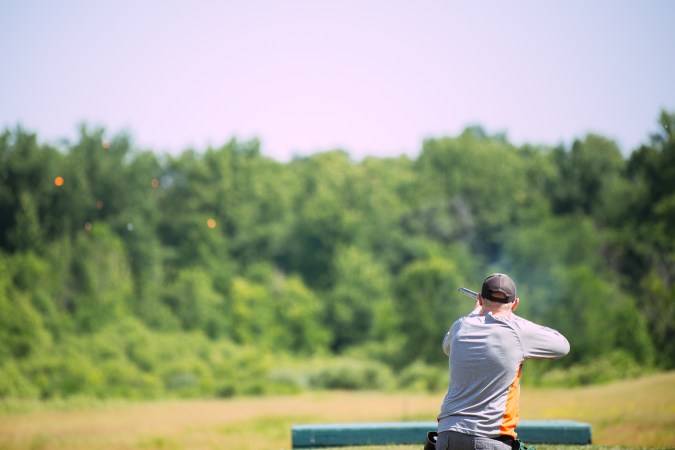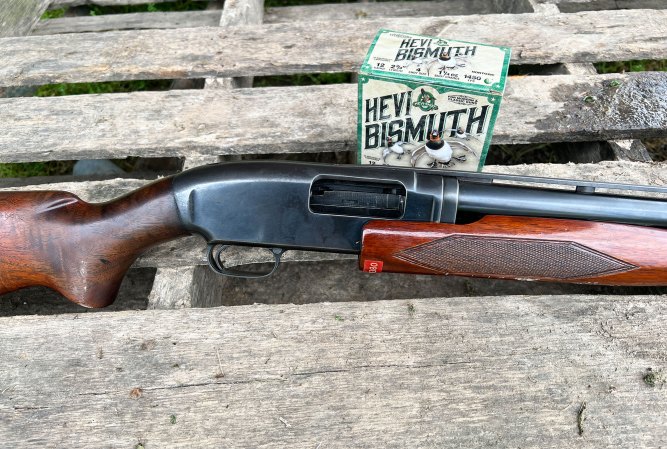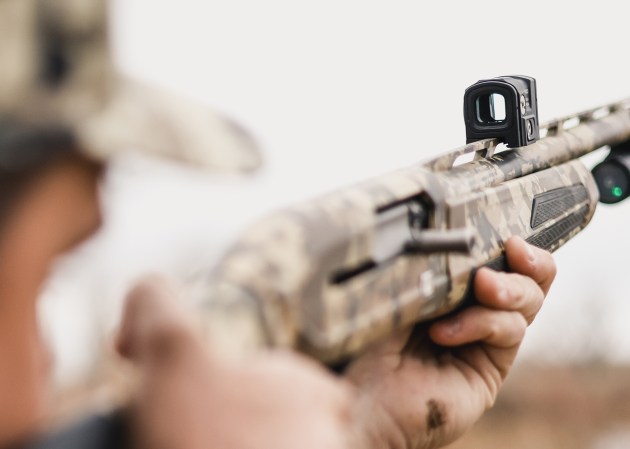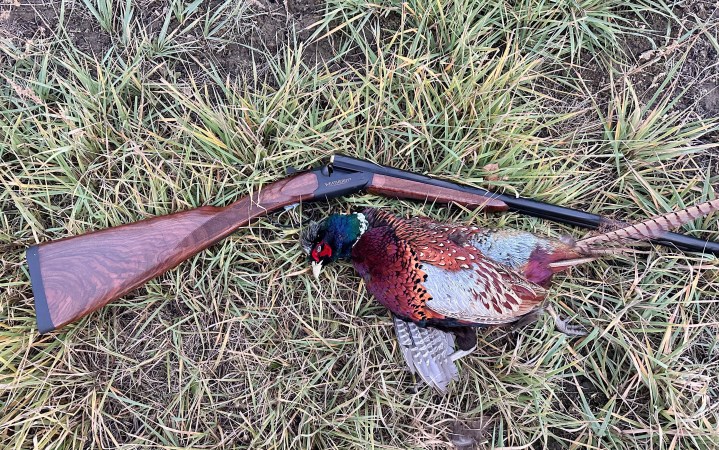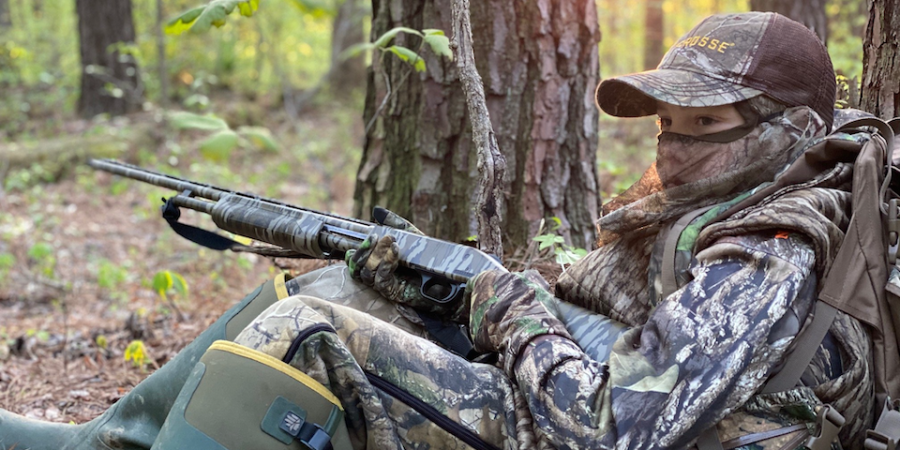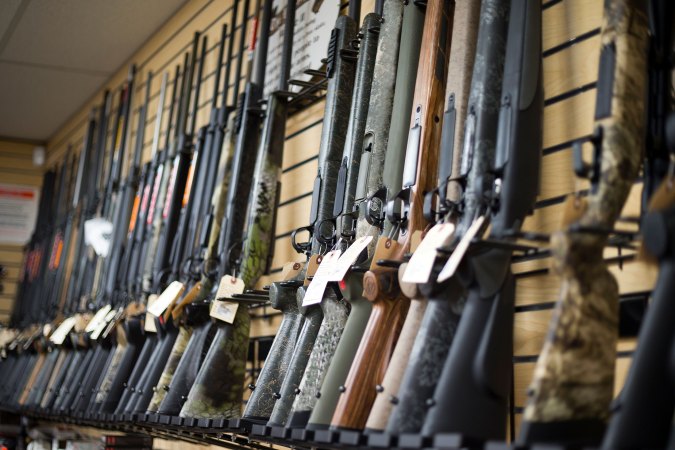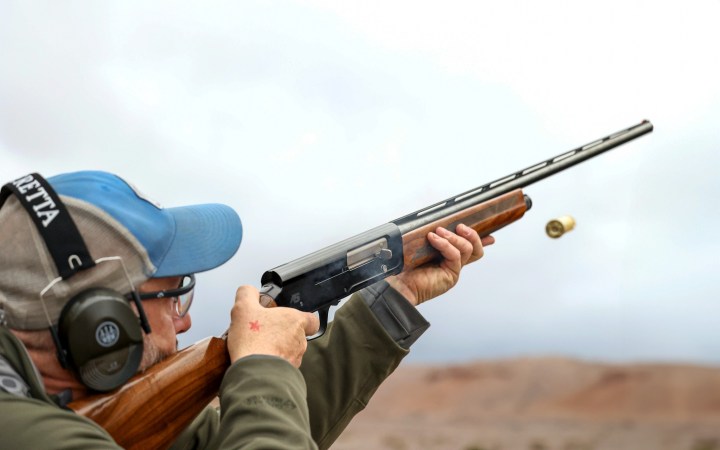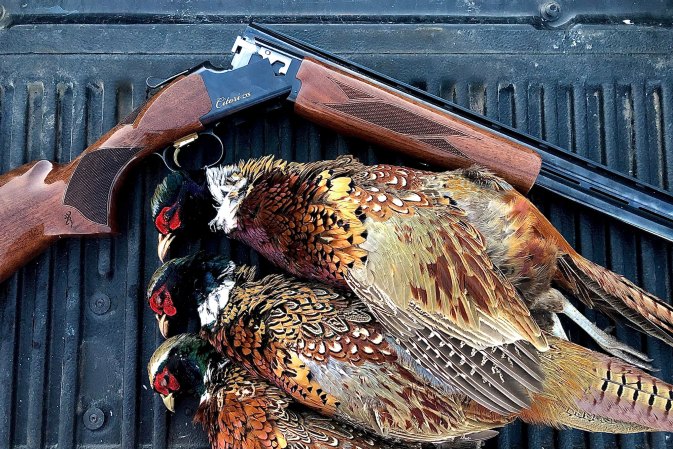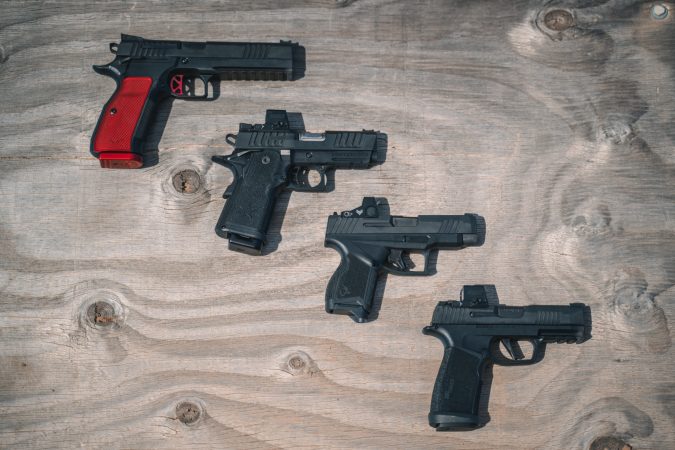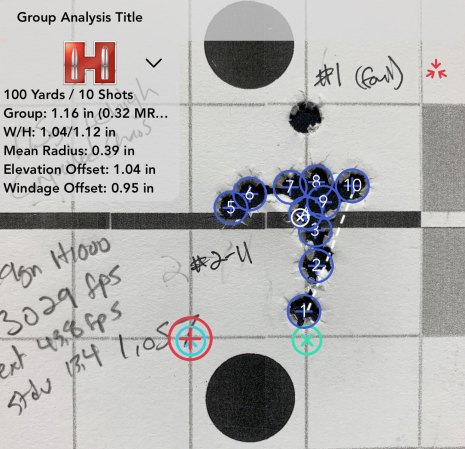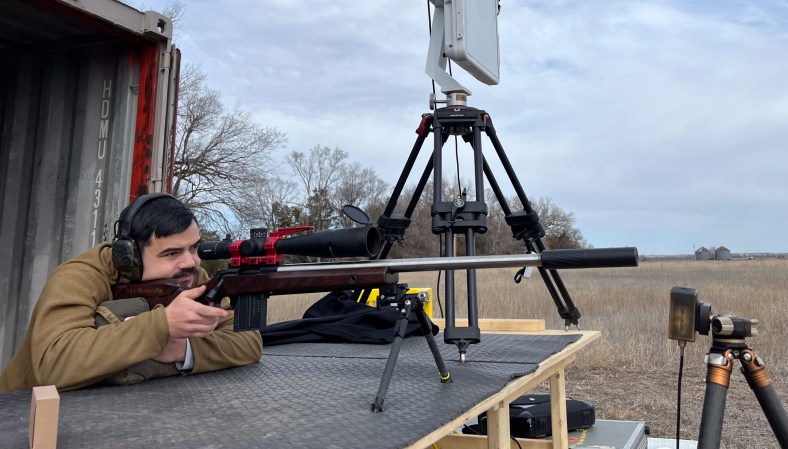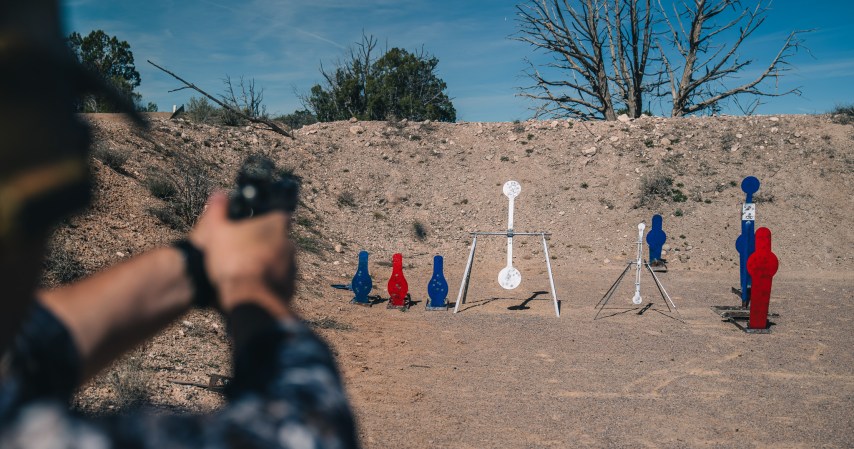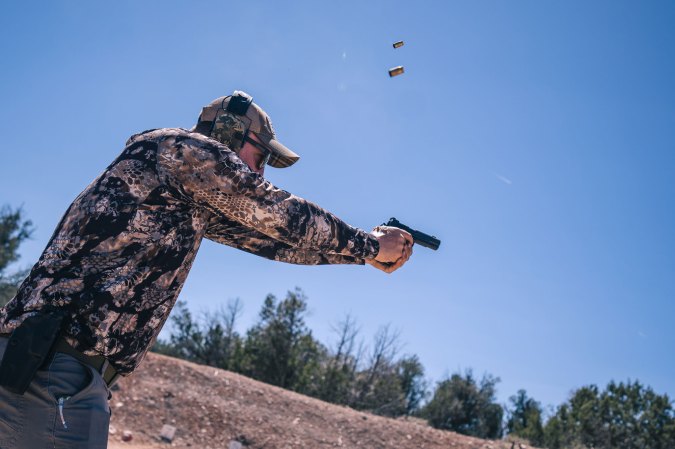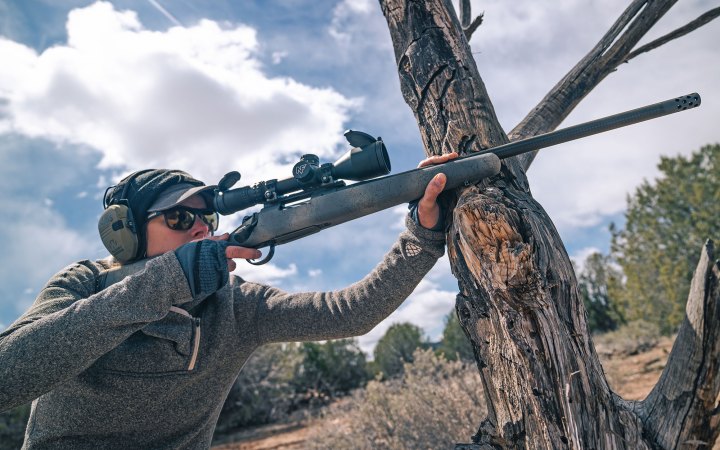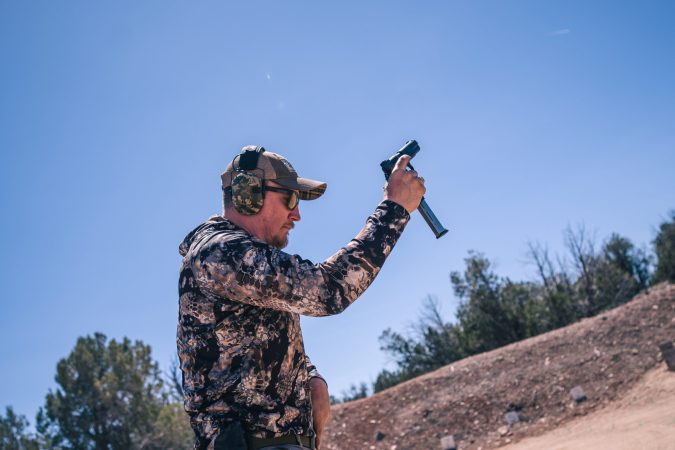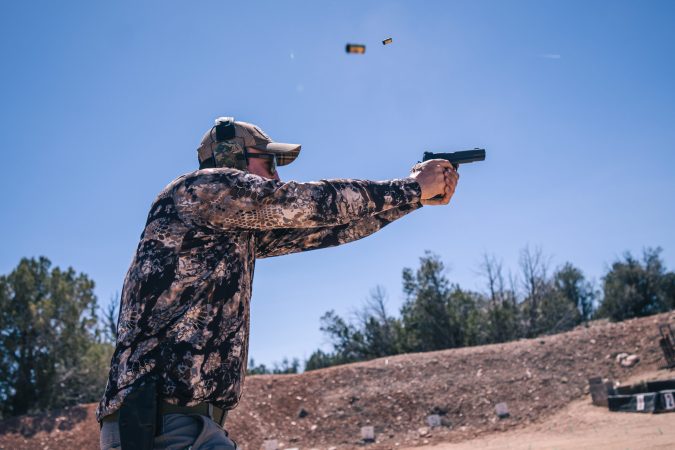We may earn revenue from the products available on this page and participate in affiliate programs. Learn More ›
In today’s frenzy of sporting clays courses, five-stand, and other assorted clays games, there is one staple that has been there through it all – skeet. If you’ve ever been to a shotgun club you’ve seen that semicircle with two “houses” on either side. Skeet is a game of skill that challenges both mental discipline and shooting ability in a 25-shot gauntlet.
If you want to learn how to get into skeet shooting, then you’ve come to the right place. In this beginner’s guide we’ll revisit the elegance, simplicity, rules, and cadence of that magical game of skeet. Plus, I’ll share some skeet shooting tips on how to break a few more clays during your next outing.
Skeet Rules and Structure
Every shooting discipline has its rules, but the game of skeet has quite a few. Skeet is founded upon regimen and consistency. This encompasses things like shooter order within your squad, which target gets thrown first, and which target is to be taken first in the instance of a double target presentation.
Founded in the 1920s as a way to improve hunters’ field shooting, skeet looks pretty much the same now as it did over a century ago.
The Skeet Field
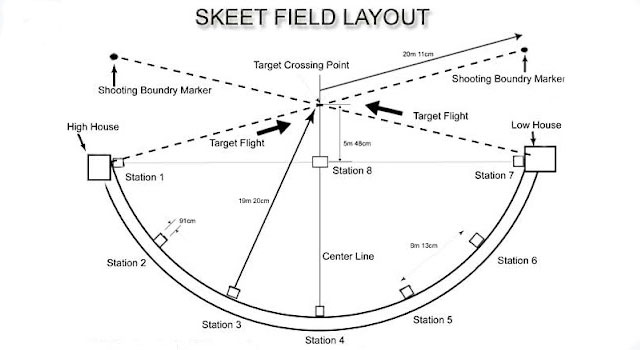
A skeet field is a semi-circle of stations anchored on the left by a high house and on the right by a low house. These are basically what they sound like – one is tall and one is short. Each house contains a window at a carefully placed location through which a clay target is thrown.
The high house window is 10 feet from the ground and the low house window is 3 ½ feet from the ground. Both targets will reach a height of 15 feet by the time they cross the center of the field. When thrown simultaneously, the targets will cross in the center of the field over the aptly named “center stake.” When targets are set correctly, the clays are to fly through a hoop positioned in the center stake. (This hoop is removed prior to shooting and is only used to determine the correct flight pattern).
There are a total of eight stations with seven completing the semi-circle and the eighth positioned in the center of the field between the two houses.
The stations in skeet are typically concrete pads or squares. A shooting squad can include up to five shooters and the same shooter leads off at each station. To get their target, the shooter calls “pull” when ready and the appropriate target is thrown.
How Skeet Is Shot
Let’s take a look at our 25 shots of skeet, station by station. A “double” means that both targets are thrown at the same time. Here’s an overview of the order that the targets are thrown for each station (you’ll notice the high house is always thrown first).
- Station 1 – High House/Low House/Double (shoot the high house target first).
- Station 2 – High House/Low House/Double (shoot the high house target first).
- Station 3 – High House/Low House
- Station 4 – High House/Low House
- Station 5 – High House/Low House
- Station 6 – High House/Low House/Double (shoot the low house target first).
- Station 7 – High House/Low House/Double (shoot the low house target first).
- Station 8 – High House/Low House/Option (or 25th shot if no targets have been missed until this point).
Re-thrown Targets and Station 8
Let’s talk about the “Option” mentioned above. In the game of skeet, the first target missed is re-thrown upon the shooters’ call (its sort of like a mulligan in golf). However, if no target is missed during the round, the 25th shot becomes an additional low house target from station eight.
Skeet Safety and Etiquette
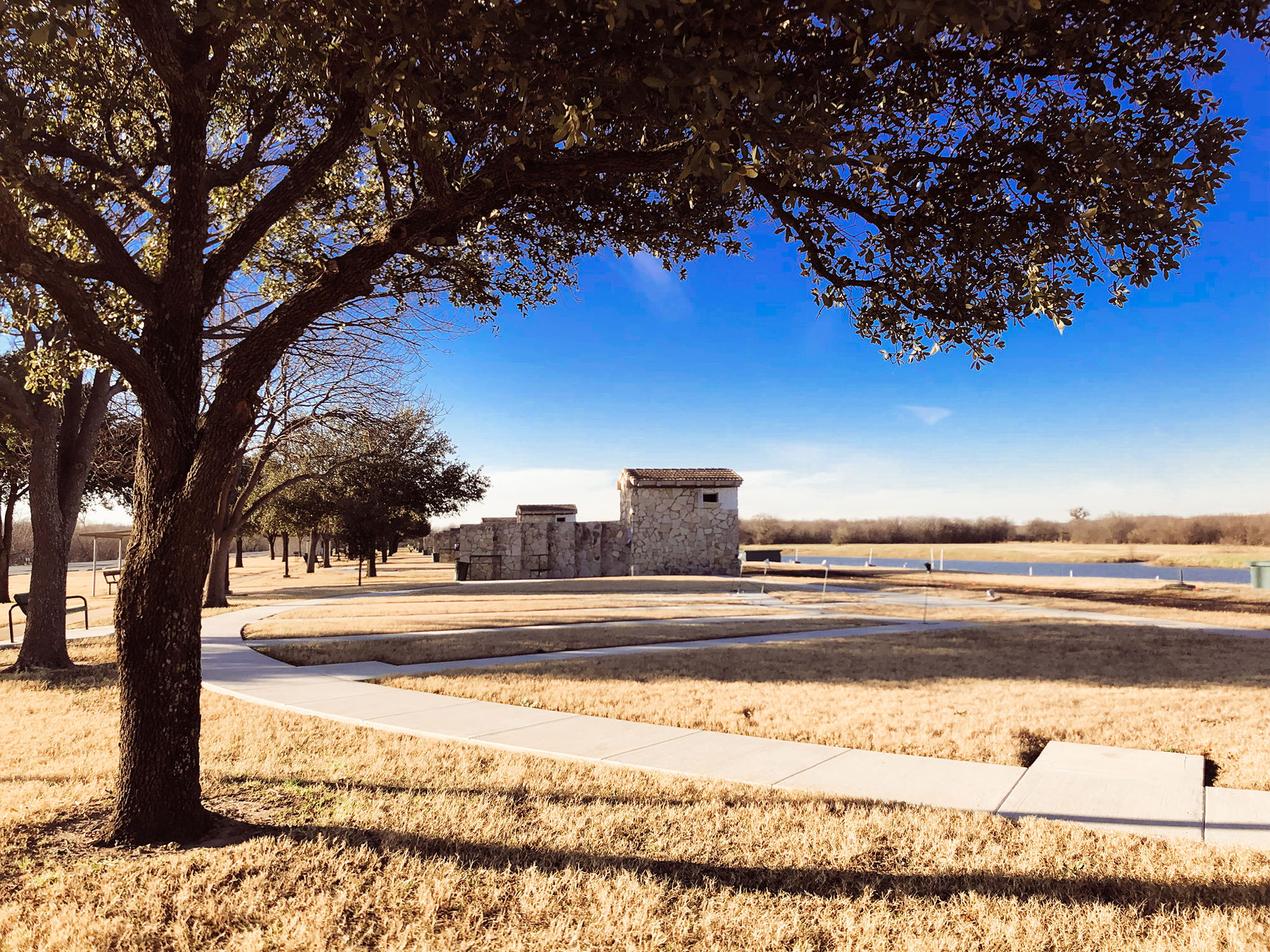
As with most shooting activities eye and ear protection is required. Proper gun safety and handling etiquette are of course mandatory.
Your gun must be broken open or bolt open (gun type depending) at all times, unless you are in the station and ready to shoot. This rule falls under both safety and etiquette and translates across the shotgun games. Upon stepping in the station, the shooter may load one or two shells. Some shooters will load two and call for the high house and low house in quick succession with no setup reset in between. Other shooters will reload and reset for each target, thus loading only one. Two shells of course need to be loaded for the doubles.
Only the shooter is to be on the station. Maintaining proper personal space behind and out of peripheral vision of the shooter is considered good etiquette. Additionally, talking while a shooter is actively executing a shot is frowned upon in some squads. Think of that as a “know your audience” type thing.
What You Need to Get Started
We’ve got the basics of what skeet is and how it works. What do you need to try it out? First, you need a shotgun. If you’re new to the shooting sports, I suggest trying as many different shotguns as you can to find out what’s comfortable for you. What works great for one person isn’t necessarily the cat’s pajamas for another. (Read our review of the best shotguns here).
Based on what we learned so far, a skeet gun needs to hold two shells, so we are looking at an over-under, side-by-side, semi-auto, or pump. We also know we want something that swings and balances well in hand. A coach gun with a 20-inch barrel is probably not your best choice.
Next, we need ammunition is that is gauge appropriate for your gun of choice and between No. 9 and No. 7 ½ shot size. Common skeet loads in common gauges include the following.
- 12 gauge: 1 ounce or 1 1/8 ounce charge weights; 7 ½, 8, or 9 shot size.
- 20 gauge: 7/8 ounce charge weights in 7 ½, 8, or 9 shot size.
For ammunition, avoid heavy field loads as they will accomplish nothing more than beating up your shoulder and shotgun unduly for the target type and distance.
Other gear needs are very standard. You’ll need a good pair of shooting glasses that offer protection, condition-appropriate color lenses (for example, avoid dark sunglasses on an overcast day) and quality glass/polycarbonate to render the target as crisply as possible.
A side note here: if you have corrected vision, talk to your eye doctor to determine the best combination of contacts/prescription lenses to achieve your desired vision needs. Remember, you need to be able to see it to shoot it.
Hearing protection is also required. I generally don’t shoot a shotgun or rifle with muffs. They interfere with my cheek-weld and ability to really engage with the gun. I prefer in-ear plugs of some variety. Find what works for you and run with it.
Lastly, you need to carry your shells around. A shooting pouch or vest of some kind is a huge help. If you want help softening recoil, a vest with a padded shooting side shoulder can be a plus.
Skeet Shooting Tips
So, how do you actually break targets while shooting skeet? Here are some tips and pointers to get you started.
Establish a Break Point
The beauty of skeet is predictability. The targets come from the same places each time and theoretically cross the center of the field in the same spot. That said, wind, mechanical quirks, and various weather conditions can impact target flight. Variables aside, many of our breaks are going to happen around the center stake.
If you’ll notice, the term is “many” and not “all.” There are exceptions to every rule. Station 1 low house and Station 7 high house are both targets that are generally taken between the center stake and the respective station from which you are shooting. This is due to proximity and angle on the singles and timing on the doubles.
Set Your Feet
Once you know your break point you need to set your feet for the shot. Everyone has their own personal style of “what works” for them. The following is a general place from which to start.
I set up for every shot on the skeet field with the big toe of my forward foot (my left foot since I am a right-handed shooter) pointed in the area I want to break the target, or a little past it.
This does a couple of things. First, it gives me a consistent foundational set up point for each presentation. Second, it gives me the ability to get good follow-through and not bind-up my upper body and chase a target across the field. Range of motion is especially important in those center stations (3, 4, and 5).
Establish a Hold Point
We have our break point and our foot position. Next, we set our hold point. This refers to where we hold our barrel in preparation for the release of the target (skeet is generally shot with a pre-mounted gun vs. a dismounted gun). Depending on the target, a generally accepted hold point is about half-way or two-thirds of the way between the center stake and the house from which the target is launched.
Skeet Shooting Tips For Each Station
Here’s a detailed look at what you can expect for some of the skeet stations and some tips on how to shoot them. Remember, at every station you want to establish your break points, set your feet, and establish hold points.
Station 1

Station 4

Station 6

Station 8

Understanding Lead
When you call “pull” the bird comes out, the flight line is acquired, and with a smooth trigger pull and buttery follow-though, the target is dusted—at least hopefully. It is here that we can get into the details of lead, which can be distilled down into the concept of where your barrel is in relation to the target along its flight path. Remember, the targets you are shooting at are moving quickly, so you must swing your barrel in front of them. The type of lead describes how you got the barrel into position ahead of the target. For the purposes of this article, we will touch on the different styles of leading a target and let you pick your own path of engagement.
Sustained Lead
This means that your barrel begins ahead of the target and stays there throughout the shot and follow through. Sustained lead is a very common skeet shooting approach, especially on the long crossing targets engaged from the center stations (3, 4, and 5).
Swing Through Lead
With this method, your barrel intercepts behind the target and accelerates through as the shot is taken.
Pull Away Lead
Some would argue that there is very little difference between this method and swing through lead. With this method, the target line is acquired and matched and then the shooter pulls the barrel ahead of the target to achieve the desired perceived lead.
While we could focus an entire article on lead alone, these are the basics. Many skeet shooters (and clay target shooters in general) claim to use one method religiously. In reality, most shooters utilize a combination of methods based on target presentation.
Final Thoughts on Getting Started in Skeet Shooting
Taking a skeet shooting lesson can be immensely helpful. Look around your area for skeet fields and ranges and find out what types of shooting opportunities they offer. Many clubs and ranges will offer instruction referrals and gun rentals so you can try different guns and learn the basics of the game.
Finding an instructor who is compatible with you and your goals can mean the difference between loving skeet and never wanting to try it again. Communicate with prospective instructors what your goals are and what you want out of the experience. Do you want a fun recreational hobby because you’ve come to the conclusion you’ll always be horrible at golf? Are you looking for a way to warm up for bird season? Or, do you want to compete? Whatever the motivation, communicate to your instructor so you can work together to achieve your goals.
Remember that shotgun shooting is supposed to be fun. Skeet is no exception. The consistency, rhythm, and elegance of a great round of skeet is good for the soul.

